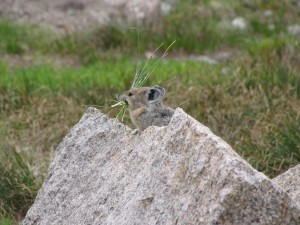
Pika sitting on a rock with a mouthful of food. Photo Courtesy of Chris Kennedy/ USFWS- Flickr Creative Commons
Climate change has been shown to be associated with dramatic changes to the terrestrial biosphere. Some of these changes include higher temperatures, the shrinking of glaciers, and shifts in animal and plant home ranges. Scientists have documented key species that are vulnerable to global warming and its effects on land. In national parks, some important species that are at risk which will be discussed further include the pika and the grizzly bear.
The discussion of specific wildlife stories can begin with the American pika. Pikas live on rock piles in cold temperature regions and cannot tolerate warmer temperatures exceeding 78 degrees Fahrenheit. They are undergoing consideration, by the US Fish and Wildlife Service, for threatened status. Pikas are related to rabbits and inhabit mountainous, alpine environments. Because they can die when exposed to warm temperatures above the threshold noted above, they move upwards in elevation, but they can only go so far before land runs out. Additional heating at higher elevations, changes in vegetation, and possible invasion by new predators, lead some scientists to believe that pikas may potentially be wiped out by due to the effects of global warming.
A “Pikas In Peril Project” is being undertaken by numerous national parks including Crater Lake, Rocky Mountain, Grand Teton, and Yellowstone National Parks. This project consists of pika monitoring and observation of distributions of pikas as well as measuring gene flow. Gene flow is the process by which DNA is spread to new areas by animal migration and interbreeding. However increased temperatures may isolate animals, reduce gene flow, and increase the likelihood of extinction of some species. A small-scale component of the larger “Pikas in Peril” study conducted at Crater Lake National Park found that after performing genetic analyses, pikas distribution can be limited by increasing temperatures, further isolating them.
A larger and more aggressive species, the grizzly bear, is also at risk due to global warming. The National Park Service recently published a document entitled “Yellowstone National Park Natural & Cultural Resources Vital Signs” which addresses many different “vital signs” that could be important indicators of the changes in the ecosystems in the parks. This document states that Yellowstone National Park is one of the last remaining refuges for grizzly bears south of Canada. Thus, the preservation of grizzly bears in national parks is essential.
Ironically, this universally known bear’s livelihood is likely to be affected by a very small beetle, the mountain pine beetle. The beetles have been known to rely on lodgepole pines which comprise forests within Rocky Mountain National Park. These beetles work their way into the phloem of the trees where they lay their eggs and finally re-emerge and infest other trees to come. Increased temperatures have widened the range of the pine beetles permitting them to reach higher elevations, and allowing the beetles to grow and reproduce more rapidly.
A relatively new target of the pine beetle is the whitebark pine which inhabits high elevations of sub-alpine habitats. With new conditions favoring beetle growth and negatively impacting tree defenses against the beetle, forests consisting of these trees are likely to be severely affected. Whitebark pine trees in the areas surrounding Yellowstone National Park are especially at risk of this devastation. The loss of whitebark pines will eliminate their nuts which comprise the fall diets of grizzly bears. These nuts have been associated with healthier bears and cubs. There are many advantages associated with the availability of whitebark pine seeds for grizzly bears to include in their diet, since they are large, durable, and nutritious with a high fat content. When present, whitebark pine seeds are preferred by bears. However as this article and the Yellowstone document demonstrate that seed production by the whitebark pine trees is highly variable, therefore bears have adapted to using alternate sources of food and may not be as fully reliant on the whitebark pine as previously expected. However both sources do call for increased research on the impacts of a loss of the whitebark pine on grizzly bear survival as the ultimate effects are still unknown.
This posting has highlighted two important terrestrial species that are at risk due to changes in Earth’s climate. It is interesting to compare the impact of climate change on both species. For example, for the pika the impact of climate change is direct while on the contrary, it is indirect for grizzly bears. Although much is known about the reliance of these species on their environments, more research is required to fully understand how climate change will ultimately affect these species. Stay tuned for next week’s posting about how climate change impacts wildlife that live in aquatic habitats.